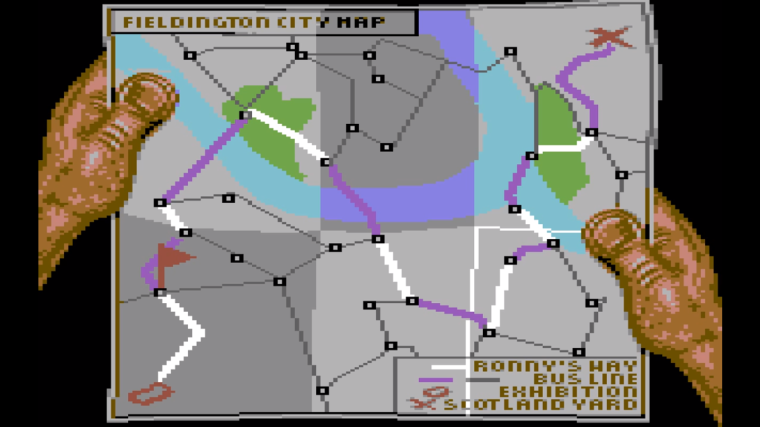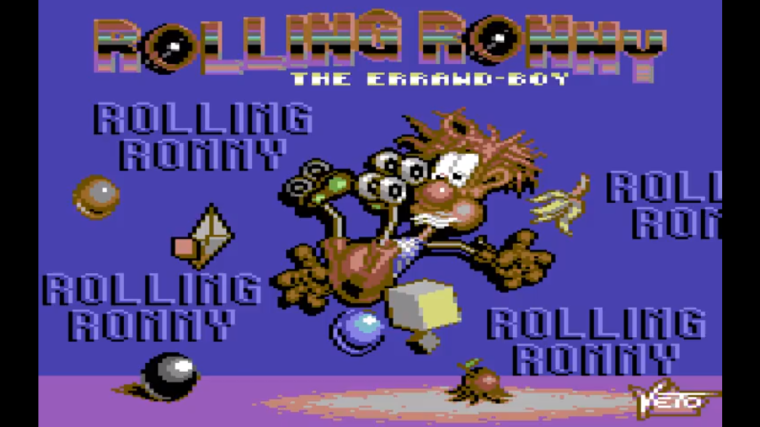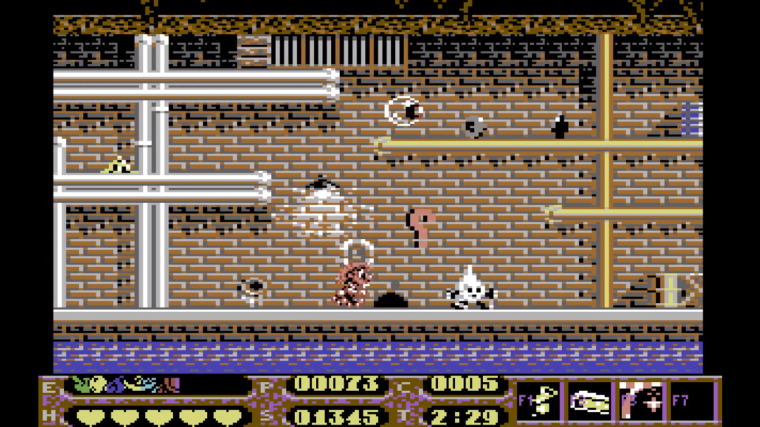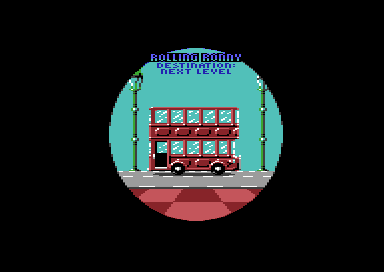How we made Rolling Ronny for the C64
An interview with the creators of the 1991 Commodore 64 game, Rolling Ronny.
Commodore Format magazine fan site
An interview with the creators of the 1991 Commodore 64 game, Rolling Ronny.
Last time, we took a look at the criminally ignored 1991 platformer Rolling Ronny. Now for the very first time Ron’s developers tell us the story behind its creation! In a world exclusive, we spoke to programmer Mario Knezovic and graphics creator, Oliver Lindau…

So guys – thanks for talking to Commodore Format! Can you tell us a bit about yourself and how you became involved with making C64 games?
OLIVER Hello, CF! Yes, I would be pleased to do so. My name is Oliver Lindau, I am in my mid-40s, cat-daddy, work as a system administrator nowadays and used to work as a professional graphic designer for computer games in the early nineties. Back then it was a mix of coincidence and my stubbornness that I ended up in the industry. I grew up in the countryside – a nerd surrounded by wheat fields. Computers or even computer games were not really a common hobby. Friends never lived around the corner and telephone calls were expensive in Germany. A friend and I enthusiastically played adventure games and eventually we were fortunate enough to publish a guide for Zak McKracken in the well-known games magazine ASM. At the same time, it was a stepping stone for me: I kept in contact with the responsible editor, sent him graphics and he told me about companies and people who were working on games. This led to my first job at the game company Magic Bytes, where I got to know Mario Knezovic and also later Markus Schneider – we became co-workers and friends. I also joined the developing team Bones Park Software Artistic, which Mario founded some time before.
MARIO As I just passed my mid forties, I grew up with the very first video and later home computer games. At age 10 I realised that not only can you create your own games with home computers, but you can also can make this a profession. and even earn money. It seemed to me to be the most exciting thing in the world to do. I started to learn programming, and after a few years couldn’t wait to finish school. I decided to quit and start working as a games programmer in 1988 – a month before my 17th birthday. All this was very adventurous back then as I was among the first few dozen professional game developers in Germany. Sometimes it was very hard to explain that I was really working and not playing games.

And how did you come to work on Rolling Ronny?
OLIVER It all started for me at a Christmas party at Starbyte Software. It was a remarkable event. I never met so many talented people at one place before. The developers showed the games they were developing including the Amiga version of Rolling Ronny. We got the offer for converting the game and if I remember correctly, we agreed almost instantly. Previous projects of Bones Park were economic simulations, which was… how to describe… rather static stuff. I usually call those games Excel-pushers. A jump-and-run is way more interesting and it is action we wanted to create.
MARIO Back then, in the C64 era, most games took only a few weeks or a couple of months to develop. So we had to keep a constant flow of new contacts and projects. One project we did in late 1991, Trans World, for German publisher Starbyte, went pretty smooth and even became our first #1 in German sales charts, so we were invited and offered to work on other titles. One concrete offering was the C64 conversion of Rolling Ronny. Even though most of the first games I programmed were simulations, I still had spent a lot of time on developing action and real-time oriented games. So it was a perfect moment to put all the learnings into a concrete game – and that would have been Rolling Ronny.
What do you remember about the process of making the game?
OLIVER Being a pixel guy – the tools were remarkable. We did not have devkit like the Katakis tools or something specified for creating game graphics. I used the editor that came with the Shoot ‘Em Up Construction Kit for sprites, which turned out extremely practical. The Ronny-sprite was created with an C64 editor called Mob-Profi, which provided overlayed hires and multicolour-sprites. The pictures in the intro and end sequence were pixeled in Koala Painter with a joystick, but everything else was more like hacking. I edited the charset with a font editor. The level backgrounds were tile-based maps, so a friend of mine coded one tool for combining 2×2 chars to tiles including the colour – and a second tool for assembling the levelmap like a puzzle game. As setup I had a C128 and Amiga 500 side by side. By the way – there was a TV and a monitor connected to the C128 at the same time, because of the the different video quality and I wanted to be sure that the graphics looked right on both display types. With our modern mouse or stylus driven tools and those workflow-trimmed programs it is hard to believe that we got things done at all back in the day when we were even lacking fundamentals such as UNDO functionality. However, I have to say that you had full control over the technical specs of the graphics and as a graphic designer you started to think like a coder.

Otherwise, I hardly remember details of the project. At least for the first month, Mario and I were working alongside each other. The intro and the end sequence were finished first. Then it was very intense and determined by crunchtime, the process was sort of first-in-first-out. The progress in code was tied to incoming graphics. Markus composed the new tunes at home far away and we had some issues with the delivery. Nevertheless the whole soundtrack reached us in time and its implementation went smoothly. Still there was no free time at all. In the final weeks weeks it became a kind of competition – like, who needs the least sleep! I also remember that the editing of the levels was pretty chaotic. Three of us worked in shifts and it took much longer than planned.
Oh I almost forgot about the communication with Virgin. That was the horror for me because I hardly spoke any English back then. David Bishop and I talked English and German mixed, which worked surprisingly well.
MARIO From a craftmanship point of view I really love the game! Technically, it is my favourite published C64 game I have made, second only to a non-published game we worked on a year later. Besides standard disciplines which could be expected for a mature system like fast soft scrolling and sprite multiplexing functions, the one feature I’d really like to point out is – because everybody can see it easily – how many of those sprite animations there are during one level! Much more than fits into the C64’s video memory. Graphics are constantly streaming from other memory areas… But unfortunately this also meant that there was not a single byte left for menu screens and such. This is the reason why loading, especially with the tape version, required some patience. Since it was a conversion, we were not responsible for the base concept, but still we even improved a few small gameplay things over the original version to make the game more playable and overall feel better. A consequence from watching Oliver work with his software was to put some effort into developing a few custom graphics tools for future projects.

It has been suggested that the game wasn’t finished and more enemies were supposed to be in there, etc, but it looks quite finished to us.
OLIVER The game was completed when it was released. The one thing is that I had prepared quite a few more sprites and an interlude screen which did not make it into the final game. For the sprites there was no RAM left and if we had included the extra screen, there would have been a disk-change in the middle of the game.
The other side concerns the gameplay. Mario and I found the level design of the Amiga version tended to be boring. Mario had already begun to vary the enemy movements for example, so that the levels feel different. Actually, we had a lot more planned in our heads. The enemy types are not clearly defined in the game. It’s sometimes not obvious what can be shot or not. The arrows in the game were up for discussion because they were not necessarily perceived as enemies. I would also like to have cleaned up the specified platforms in the background. If the railing and ground are one finger apart, one of them is actually over the other. But there was no time for such ideas at the end of the development.
MARIO Since we were only doing an Amiga conversion, from our point of view it was complete as it basically contained what the original version contained too. But we felt something was lacking too, so we tried to make many small improvements and tried to make everything which was there as good as we could.

How did you feel about the reviews of the game at the time?
OLIVER Frankly, I neither felt thrilled nor disappointed. The C64 version of Ronny came out a little later than the Amiga version and reviews were already uneven, but usually rather average. It was not to be expected that it would be different for the 8-bit version. Commodore Format was an exception. The review was too harsh in my opinion, because the game was downgraded for wrong reasons. However, I also didn’t get why Virgin distributed only the tape version to magazines for review.
MARIO First of all, besides all the effort we have put into the game, it was very clear to me that it was only an average game. It was also a time when people were hungry for new 16-bit gaming hardware and newer, more complex concepts. And I was no different! So all I expected were average reviews hopefully mentioning that the game was still well crafted. And that’s exactly what happened! Most reviews were very average. But there were a few cases where the C64 version had a notably better review than all other versions – including the original! So, honestly, all in all I was very happy with the reviews!
It must be gratifying to know people have become very fond of Rolling Ronny. Over time it has become so loved!
OLIVER It was quite a surprise. At that time, we had no feedback on whether players actually liked the game or not, except those two or three magazine reviews. There were no groups of beta testers back then. It was at a 2008 demo scene party when someone first told me that it was one of his favourite games as a kid. I also discovered there was a second release in the Golden Disk budget series, which got much more attention. I finally learned about the reviews in the ZZAP! and Commodore Format or a thread in the Lemon 64 forum, where people were discussing the game enthusiastically. It felt bizarre and touching, that moment. I just enjoy it.
MARIO Indeed, it is very gratifying! Over time, expectations have become realistic again. Those who still love C64 games now know very well what can be expected from a C64 game. And once you also accept that Ronny will neither contest for a game design award, nor for a spot in the eternal C64 top 10, you can start enjoying what actually is there: A laid-back jump’n’run with a well playable character, plenty of beautiful animations in long levels, with really nice fitting music. I am very grateful about the long-term reactions.

Finally, are you guys still active in C64 world? What do you do?
OLIVER Yes, the C64 is still my favorite hobby. I am also active as a pixel artist and game designer – mainly in the demo scene and for game creation. In the scene you can find me under the handle v3to and I am a member of the groups Oxyron, TRSi and PriorArt. Projects that I participated in were the demos Coma Light 13 and Comaland, the point-and-click adventure Caren and the Tangled Tentacles and Donkey Kong Arcade.
MARIO In contrast to Oliver not at all! But I love to hear news from him occasionally. Today I work as a self-employed developer. In the past year I have mainly worked on Virtual Reality projects developed using the Unreal Engine. CF
Thanks to Oliver and Mario for helping us to bring you another Commodore Format world exclusive! We’ll leave you with something a bit special. Oliver mentions a loading screen that couldn’t be included in the final game. After 27 years, here it is 🙂

The Commodore Format review was ridiculous. Shame on Stuart Campbell for that. Rolling Ronny was a superb platform game with a neat puzzle element (it forced you to think what power-up to use where). The back and forth reminded me a bit of Hawkeye and Flimbo’s Quest, but imo Rolling Ronny was way better than either of these two games.
LikeLiked by 2 people
Awesome interview and a cherry on the cake! The only thing I missed in Rolling Ronny as a concept was that Ronny actually doesn’t feel like he rolls 😀 as there are no skating physics attached. That was my only disappointment, but when I got into the game, I changed my mind quickly. Still, the distinction between front and background is a small downside of this game, but the parallax of the sky/ceiling is really nice, and the game offers a lot even nowadays :). It’s a good point that you have to know the limitations of the machine. However, no matter what, it’s a really good, funky game!
LikeLiked by 1 person